
Browse an alphabetical list of photographs. These historical images portray people, places, and events before, during, and after World War II and the Holocaust.
<< Previous | Displaying results 551-600 of 2641 for "Photo" | Next >>
Circular label from the suitcase used by Margot Stern when she was sent on a Kindertransport to England. Germany, December 1938.
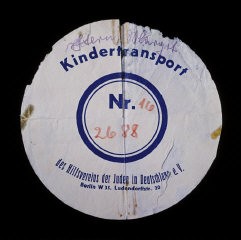
Chiune Sugihara, Japanese consul general in Kovno, Lithuania, who in July-August 1940 issued more than 2,000 transit visas for Jewish refugees. Helsinki, Finland, 1937–38.
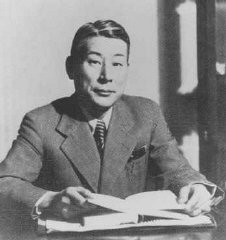
Christoph Probst, a member of the White Rose student opposition group. Probst, arrested and condemned to death by the People's Court, was executed on February 22, 1943.
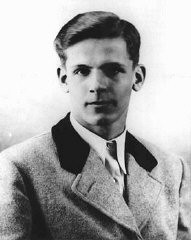
Propaganda played a crucial role in selling the myth of the "national community" (Volksgemeinschaft) to so-called "Aryan" Germans. The photograph on this cigarette card was taken by Nazi propagandist Heinrich Hoffman. It depicts a crowd of people smiling and giving the Nazi salute as a guard holds them back. Written in German, the caption on the back reads, "Every day the same picture: Fans welcome the leader." Beginning in the 1920s, cigarette cards were a popular collectible item in Germany. This card…
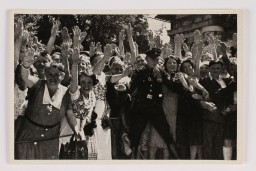
Cigarette card portraying some of the American track and field athletes who competed in the 1936 Olympics in Berlin, Germany. The US team was the second largest to compete in the 1936 Summer Olympic Games with 312 members, including 18 African Americans. Cigarette cards were collectible cards often included in packages of cigarettes into the 1940s.
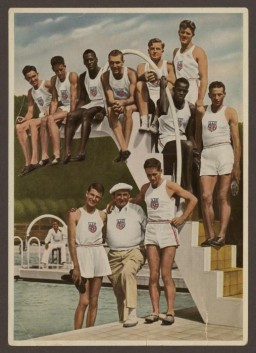
Clandestine photograph, taken by a German civilian, of Dachau concentration camp prisoners on a death march south through a village on the way to Wolfratshausen. Germany, between April 26 and 30, 1945.
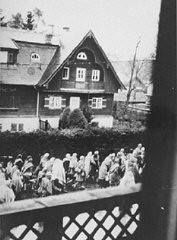
A class for new immigrants in the United States. Postwar.
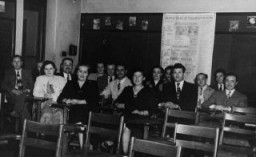
A first-grade class at a Jewish school. Cologne, Germany, 1929-1930.
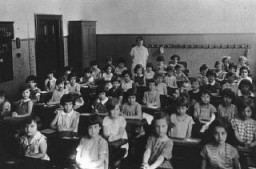
Ruth Kohn (top row, second from left) and her classmates at a school in Prague. Prague, Czechoslovakia, 1928.
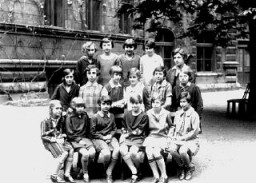
Close-up of corpses piled in the crematorium mortuary in the newly liberated Dachau concentration camp. Dachau, Germany, May 1945. This image is among the commonly reproduced and distributed, and often extremely graphic, images of liberation. These photographs provided powerful documentation of the crimes of the Nazi era.
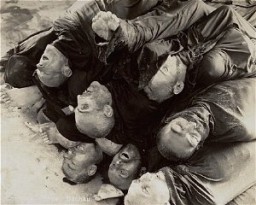
Close-up portrait of Hebrew and Yiddish author Itzhak Katzenelson in the Vittel internment camp. Because he possessed a Honduran passport, Katzenelson and his son were sent to the Vittel internment camp in France. They remained there for a year, during which time Katzenelson continued to write. In April 1944, however, both were deported to their death in Auschwitz. Vittel, France, 1943-1944.
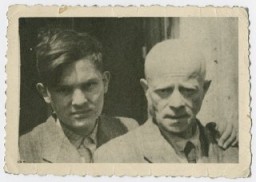
Close-up portrait of Miriam Wattenberg (Mary Berg). Because Mary's mother was American, she and her family were sent from the Warsaw ghetto to Vittel in to be held for possible prisoner exchange. Her diary became the first wartime published eyewitness account in English of life in the Warsaw ghetto and the deportation of its inhabitants to be murdered at Treblinka.
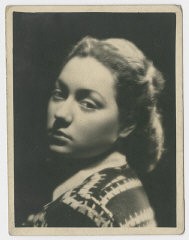
Collage created after the Nazi regime began to force gay and lesbian gathering spaces to close. It was published in the magazine, Der Notschrei. Berlin, March 1933.
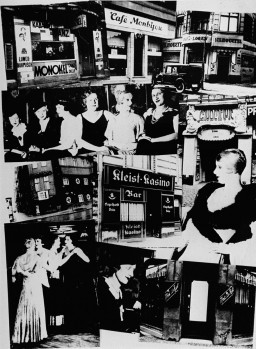
Coffins containing bodies of Jews killed in the Kielce pogrom. Poland, July 6, 1946. The mass violence of the Kielce pogrom drew on an entrenched local history of antisemitism–especially false allegations accusing Jews of using the blood of Christian children for ritual purposes (a charge known as a “blood libel”)–with the intent of discouraging the return of Jewish Holocaust survivors to Poland.
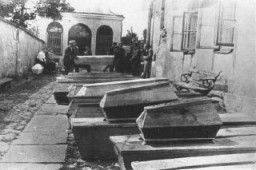
In the International Military Tribunal courtroom, executive trial counsel Colonel Robert G. Storey presents evidence of Nazi intentions to launch an aggressive war.
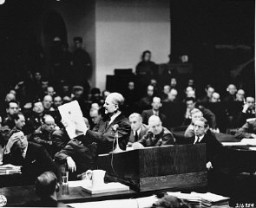
A column of refugees in the Soviet Union, following the German invasion of Soviet territory on June 22, 1941. Soviet Union, between 1941 and 1944.
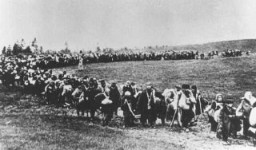
Column of Soviet prisoners of war from the eastern front. Kharkov, Soviet Union, June 18, 1942.

Commandant Arthur Roedl (center) and SS officers visit the Gross-Rosen concentration camp's quarry. Gross-Rosen, Germany, 1941.
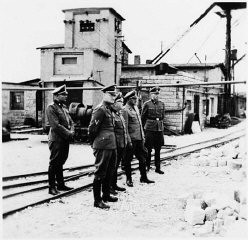
Commemorative postcard with a drawing of barrack 11 of Bergen-Belsen and marking the time the people on the Kasztner train spent in the camp. The Jews from the Kasztner transport lived in two barracks, 10 and 11, inside Bergen-Belsen. (This was probably drawn by the Hungarian artist Robert (Imre) Irsay who himself was on the Kasztner transport.)
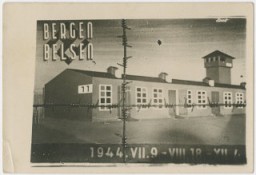
Ernst Thaelmann, leader of the German Communist Party, was detained during a mass arrest of Communists following the fire that virtually destroyed the Reichstag (German parliament) building. Germany, date uncertain.
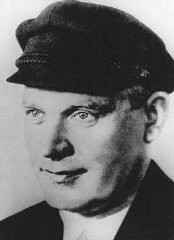
Joseph Levi, a pharmacist and the head of the Jewish community of Komotine, wearing the compulsory Jewish badge. Bulgarian occupation authorities later deported him to the Treblinka killing center. Komotine, Greece, 1942.
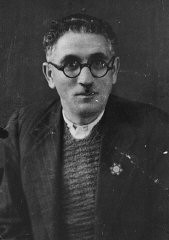
Soon after liberation, women camp survivors prepare food near piles of dead bodies. Bergen-Belsen, Germany, after April 15, 1945.
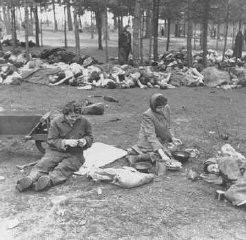
Prisoners receive meager food allocations at the Plaszow camp. Krakow, Poland, 1943 or 1944.
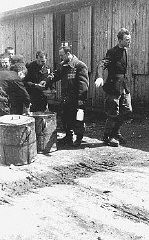
Forced laborers work on the construction of a wall around the Warsaw ghetto area. The Germans announced the construction of a ghetto in October 1940 and closed the ghetto off from the rest of Warsaw in mid-November 1940.
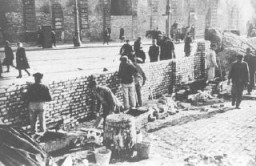
View of the dam being built by forced laborers from the Im Fout labor camp in Morocco. Photograph taken 1941-42.
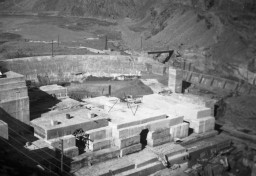
View during the construction of Oskar Schindler's armaments factory in Bruennlitz. This photograph shows the construction of a rail line to the factory. Czechoslovakia, October 1944.
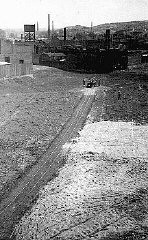
Installation of the railcar at the construction site of the United States Holocaust Memorial Museum. Washington, DC, February 9, 1991.

Containers of Zyklon B poison gas pellets found at the Majdanek camp after liberation. Poland, after July 22, 1944.
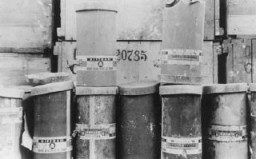
Portrait of Secretary of State Cordell Hull signing President Franklin D. Roosevelt's neutrality proclamation. September 5, 1939.
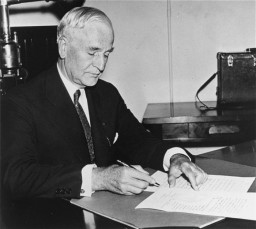
Corpses found by US soldiers after the liberation of the Gunskirchen camp, a subcamp of the Mauthausen concentration camp. Austria, after May 5, 1945.
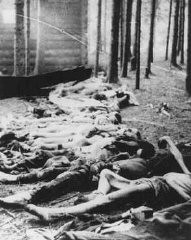
Corpses found when US troops liberated the Gusen camp, a subcamp of the Mauthausen concentration camp. Austria, after May 12, 1945.
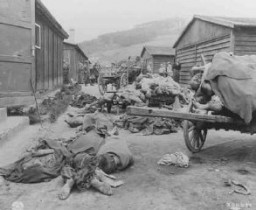
A pile of corpses in the newly liberated Dachau concentration camp. Dachau, Germany, April 29-May 1945. This image is among the commonly reproduced and distributed, and often extremely graphic, images of liberation. These photographs provided powerful documentation of the crimes of the Nazi era.
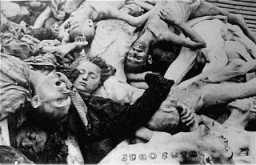
Piles of corpses, soon after the liberation of the Mauthausen camp. Austria, after May 5, 1945.
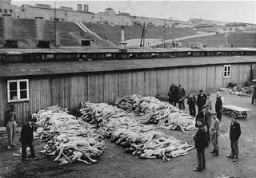
Corpses are piled in the crematorium mortuary in the newly liberated Dachau concentration camp. Dachau, Germany, May 1945. This image is among the commonly reproduced and distributed, and often extremely graphic, images of liberation. These photographs provided powerful documentation of the crimes of the Nazi era.
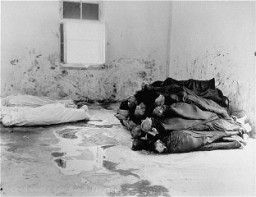
Corpses of inmates from the Klooga camp stacked for burning. Soviet troops discovered the bodies when they liberated the camp. Estonia, September 1944.
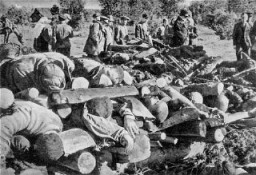
Corpses of inmates from the Klooga camp stacked for burning. Soviet troops discovered the bodies when they liberated the camp. Estonia, September 1944.
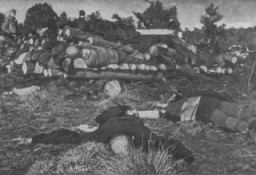
Corpses of prisoners killed in the Gunskirchen camp. Gunskirchen was one of the many subcamps of the Mauthausen camp. It was liberated by US forces in early May 1945. Gunskirchen, Austria, photo taken between May 6 and May 15, 1945.
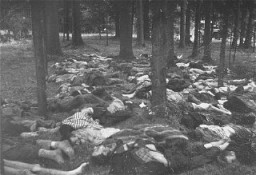
Corpses of inmates discovered by Soviet troops at the Klooga forced-labor camp. Nazi guards and Estonian collaborators had executed the prisoners and then stacked the bodies for burning. Estonia, September 1944.

American radio journalists view corpses in the Buchenwald concentration camp. This photograph was taken after the liberation of the camp. Germany, April 18, 1945. Pictured from left to right are, Lowell Thomas (NBC); Howard Barnes (WOR); and George Hamilton Combs (WHN).
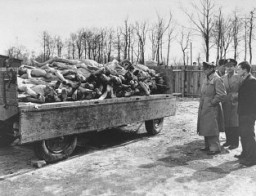
A counterfeit British bank note produced by Jewish forced laborers employed in Operation Bernhard at the Sachsenhausen concentration camp. Under an order issued by SS chief Heinrich Himmler in 1942, Operation Bernhard initially aimed to produce large quantities of counterfeit British bank notes. The goal was to flood the British currency market and trigger a financial crisis.
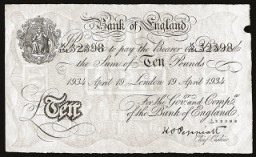
Three couples pose with their babies in the Gabersee displaced persons (DP) camp in Germany, 1947. In the center are David and Bella Perl (later spelled Pearl), who met and married after the war, with their daughter, Rachel. During the Holocaust, Bella Scheiner and her family were deported to Auschwitz. From there, she was sent to forced labor at Reichenbach, a sub-camp of Gross-Rosen. Bella met David—who had lost his wife and child during the war—while working at a photography studio after…
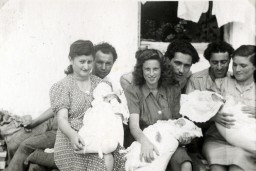
View of the courtroom during the Dachau concentration camp trial. November 15-December 13, 1945.
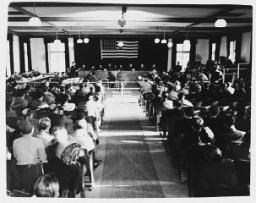
View of the courtyard in the Breendonk fortress prison where prisoners lined up for roll call. Breendonk, Belgium, postwar. This image is taken from a series of snapshots sold on the site after the end of World War II.
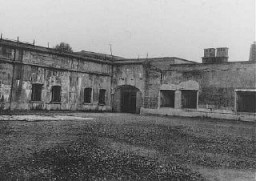
Cover of Ernest Hemingway's A Farewell to Arms. (1929 cover. Princeton University Library.) In 1933, Nazi students at more than 30 German universities pillaged libraries in search of books they considered to be "un-German." Among the literary and political writings they threw into the flames during the book burning were the works of Ernest Hemingway.
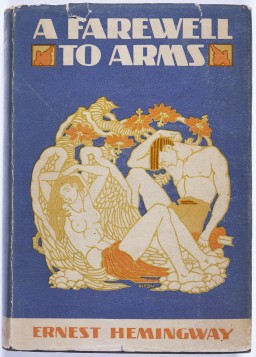
Cover of a German antisemitic book for children, Der Giftpilz (The Poisonous Mushroom), published in Germany by Der Stuermer-Verlag.
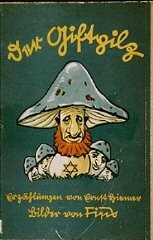
Cover of a memorial booklet for Lisa Derman (Lisa Derman: An Extraordinary Woman, An Extraordinary Life, published by Louis Weber Publications International, Ltd.).
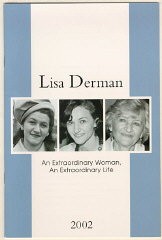
Sigmund Freud: Massenpsychologie und Ich-Analyse, cover. In 1933, Nazi students at more than 30 German universities pillaged libraries in search of books they considered to be "un-German." Among the literary and political writings they threw into the flames were all the works of Sigmund Freud that were published by 1933.
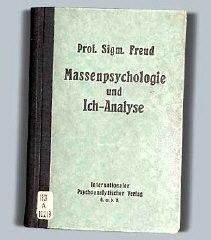
Cover of an antisemitic German children's book titled Trust No Fox in the Green Meadow and No Jew on his Oath, published by Der Stürmer-Verlag (publishing company of Julius Streicher). Germany, 1936.
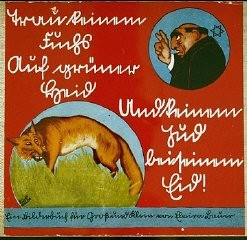
Cover of an underground Yiddish newspaper, Jugend Shtimme (Voice of Youth). Writing on the bottom of the cover reads: "Fascism must be smashed." Warsaw ghetto, Poland, January–February 1941.

The cover of a diary written by Elizabeth Kaufmann while living with the family of Pastor André Trocmé in Le Chambon-sur-Lignon. Le Chambon-sur-Lignon, France, 1940–41.
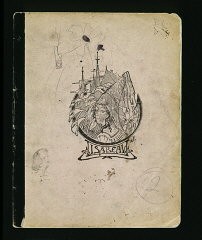
We would like to thank Crown Family Philanthropies, Abe and Ida Cooper Foundation, the Claims Conference, EVZ, and BMF for supporting the ongoing work to create content and resources for the Holocaust Encyclopedia. View the list of donor acknowledgement.